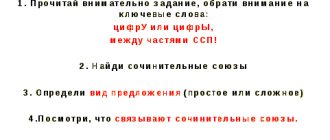Grade standards for subjects in primary school according to the Federal State Educational Standard
Subject grading standards
Russian language
Test dictation 1. The volume corresponds to the number of words in reading. 2. Non-gross errors: • Exceptions to the rules • Repetition of the same letter • Hyphenation of words • Single omission of a letter at the end of a word 2 minor errors = 1 error 3. Generic errors: The first three generic errors = 1 error, but each subsequent similar one is counted as separate error. 1. With 3 amendments, the score is reduced by 1 point. Marks for the control dictation: “5” - not given if there are 3 corrections, but can be given if there is one minor mistake. “4” – 2 spelling and 2 punctuation errors or 1 spelling and 3 punctuation errors. “3” – 3-4 spelling and 4 punctuation errors, as well as 5 spelling errors. “2” – more than 5-8 spelling errors. “1” – more than 8 spelling errors. Scores for grammar tasks “5” - all correct “4” - at least ¾ correct “3” - at least ½ correct “2” - more than half of the task was not completed “1” - more than one task was not completed Scores for vocabulary dictation (if number of words 15-20) "5" - no errors "4" - 1-2 errors "3" - 3-4 errors "2" - 5-7 errors "1" - more than 7 errors Number of words for vocabulary dictation 1st grade – 7-8 words 2nd grade – 10-12 words 3rd grade – 12-15 words 4th grade – up to 20 words Vocabulary dictations are carried out as current ones in workbooks, and as tests – in tests. Lists of words are given in the program and also at the end of the textbook. Marks for test cheating "5" - no errors "4" - 1-2 errors or 1 correction (grade 1) 1 error or 1 correction (grades 2-4) "3" - 3 errors and 1 correction (grade 1) 2 errors and 1 correction (grades 2-4) “2” - 4 errors (grade 1) 3 errors (grades 2-4) An error is considered:
• Violation of spelling rules when writing words • Omission and distortion of letters in words • Replacement of words • Absence punctuation marks within the program of a given class.
• Incorrect spelling of words that are not checked by the rule The following are not considered an error: • Errors in those sections of spelling and punctuation that were not studied in this class or in previous ones (work is carried out on these words or this word is written on the board) • A single omission of a period at the end of a sentence if the first word of the next sentence is capitalized. • A single case of replacing one word without distorting the meaning. The following counts as 1 error:
• Two corrections • Two punctuation errors • Repetition of errors in the same word. If a similar error occurs in another word, it is considered an error. The following are considered minor errors: • Repetition of the same letter in a word • Unfinished word • Wrangling of a word • The same word written twice in a sentence
Mathematics
Test.
Examples. "5" - no errors "4" - 1-2 errors "3" - 2-3 errors "2" - 4 or more errors Test work. Tasks. "5" - no errors "4" - 1-2 minor errors "3" - 2-3 errors "2" - 3 or more errors Combined test work. “5” - no errors “4” - 1-2 errors, but not in the problem “3” - 2-3 errors, 3-4 not gross, but the solution to the problem is correct “2” - problem not solved or more than 4 serious errors Gross errors:
1. computational errors in examples and problems 2. procedure, incorrect solutions to the problem 3. failure to complete the solution of the problem, example, uncompleted task
Minor errors:
1. irrational calculation methods 2. incorrect formulation of the question for action when solving the problem 3. incorrectly formatted answer in the problem 4. incorrect copying of data 5. failure to complete transformations Note: • For grammatical errors made in mathematics work, the grade is not reduced • For carelessly formatted work, non-compliance with rules and calligraphy, the grade is reduced by 1 point.
Literary reading
Reading skill (pace, method, correctness, understanding)
Grade 1 In Grade 1, verbal assessments are used: “you read well”; “you read well, but there are mistakes”; “You’re still reading slowly and with mistakes, so you need to read more.” The grade “read well” - the student reads in whole words, reads words of more than three syllables syllable by syllable, clearly pronounces sounds and words, observes the emphasis in words, does not make mistakes, the reading pace is 25-30 words and a minute. The assessment is “you read well, but there are mistakes” - the student reads in whole words and syllables, clearly pronounces sounds and words, but makes 1-2 mistakes, the reading pace is 20-25 words per minute. The assessment is “you are still reading slowly and with errors...” - the student reads syllable by syllable, makes more than three errors, the reading pace is 15-20 words per minute or lower. Grade 2 Grade “5” - the student reads in whole words, clearly pronounces the words being read; reading pace - at least 50 words per minute, maintains correct intonation depending on punctuation marks, gives complete answers to questions about the content of the text read. Score “4” - the student reads more than 40 words per minute in whole words, maintains the required intonation and pauses, accurately conveys the content of what was read (partly with the help of the teacher’s questions), and does not make gross speech errors. Score “3” - the student reads syllables correctly at a speed of less than 40 words per minute; conveys the content of what was read using the teacher’s questions. Score “2”—the student reads syllables correctly at a speed of less than 30 words per minute; conveys the content of what was read using the teacher’s questions. Score “1” - the student reads syllables correctly at a speed of less than 20 words per minute; does not convey the content of what was read using the teacher’s questions. Grade 3 Score “5” - the student reads in whole words, at a speed of 60 or more words per minute out loud and more than 80 words per minute silently, with correct intonation; knows how to convey the content of what he read in detail and concisely and express his own informed judgment about it. Score “4” - the student reads the text aloud in whole words, at a speed of at least 55 words per minute, with correct intonation; knows how to convey the content of what he read; silent reading rate of at least 70 words per minute. Score “3” - the student reads whole words at a speed of at least 45 words per minute, in some cases switches to syllabic reading; makes no more than five mistakes; makes 1-2 mistakes in answering questions based on the text; silent reading rate of at least 60 words per minute. Score “2” — the student reads whole words at a speed of at least 35 words per minute, often switches to syllabic reading; makes no more than seven mistakes; makes 3-4 mistakes in answering questions based on the text; silent reading rate of at least 60 words per minute. The student does not fulfill the requirements corresponding to Fr. Score “1”—the student reads whole words at a speed of less than 35 words per minute, syllable by syllable; makes more than seven mistakes; makes more than 4 mistakes in answering questions about the text; silent reading rate less than 60 words per minute. The student does not fulfill the requirements that meet Fr. Grade 4 Score “5” - the student reads whole words at a speed of at least 90 words per minute out loud and more than 110 words silently; knows how to formulate the main idea of what he read, and for this purpose the necessary parts of the text he read. Grade “4” - the student reads whole words at a speed of at least 70 words per minute out loud and more than 90 words silently; when formulating the main idea of a work, resorts to the help of a teacher; can write a story about a hero; understands the main idea; knows how to express his opinion about what he read. Score “3” - the student reads whole words at a speed of at least 60 words per minute out loud and at least 80 words silently; determines the main idea of the work with the help of the teacher; finds it difficult to briefly retell what he has read; the story about the hero is compiled according to the plan proposed by the teacher; understands the content of the work and can answer questions (sometimes with the help of the teacher). Grade “2”—the student reads whole words at a speed of at least 50 words per minute out loud and at least 70 words silently; does not determine the main idea of the work with the help of the teacher; finds it difficult to briefly retell what he read with the help of a teacher; the story about the hero does not follow the plan proposed by the teacher; understands the content, but may not answer all questions. Score “1”—the student reads whole words at a rate of less than 50 words per minute out loud and less than 70 words per minute silently; does not define the main idea of the work; finds it difficult to briefly retell what he has read; the story about the hero does not compose, does not understand the content. Checking the level of reading and reading skills to work with the text of a work of fiction Work with tasks of approximately the same complexity can be assessed by the sum of correct answers. “5” - if all tasks are completed correctly; “4” - if at least ¾ of all tasks are completed; “3” - if at least ½ of all tasks are completed; “2” - if less than 1/2 of all tasks are completed; “1” - if the task is not completed at all. Oral answers A grade of “5” is given if the student: fully presents the studied material, gives the correct definition of language concepts; demonstrates an understanding of the material, can substantiate their judgments, apply knowledge in practice, give the necessary examples not only from the textbook, but also compiled independently; presents the material consistently and correctly from the point of view of the norms of literary language. A grade of “4” is given if the student gives an answer that satisfies the same requirements as for a grade of 5, but makes 1-2 errors, which he himself corrects, and 1-2 shortcomings in the sequence and linguistic design of what is presented. A grade of “3” is given if the student demonstrates knowledge and understanding of the main provisions of this topic, but: presents the material incompletely and allows inaccuracies in the definition of concepts or the formulation of rules; does not know how to substantiate his judgments deeply and convincingly enough and give his examples; presents the material inconsistently and makes mistakes in the language of the presentation. A grade of “2” is given if the student reveals ignorance of most of the relevant section of the material being studied, makes mistakes in the formulation of definitions and rules that distort their meaning, and presents the material in a disorderly and uncertain manner. A grade of 2 indicates deficiencies in the student’s preparation that are a serious obstacle to successful mastery of subsequent material. Reading poems by heart Rating “5” - firmly, without prompting, knows by heart, reads expressively. Score “4” - knows the poem by heart, but allows for rearrangement of words when reading, independently corrects any inaccuracies. Rating “3” - reads by heart, but when reading reveals an unsteady assimilation of the text. Score “2” - breaks the sequence when reading, does not fully reproduce the text. Rating “1” - does not know the poem at all. Expressive reading Requirements for expressive reading: 1. Correct placement of logical stress 2. Observance of pauses 3. Correct choice of tempo 4. Maintaining the required intonation 5. Error-free reading Score “5” - all requirements are met correctly Score “4” - not met 1-2 requirements Score “3” - errors were made on three requirements Score “2” - errors were made on more than three requirements Score “1” - errors were made on all requirements. Reading by roles Requirements for reading by roles: 1. Start reading your words in a timely manner. Select the correct intonation 3. Read accurately 4. Read expressively Score “5” - all requirements are met Score “4” - errors were made on one requirement Score “3” - errors were made on two requirements Score “2” - errors were made on three requirements Score “1” - mistakes were made on all requirements Retelling the text Score “5” - retells the content of what was read independently, consistently, without missing the main thing (in detail or briefly, or according to plan), answers the question correctly, knows how to support the answer to the question by reading relevant passages. Rating “4” - makes 1-2 mistakes, inaccuracies, corrects them himself Rating “3” - retells the story with the help of leading questions from the teacher, cannot consistently convey the content of what he read, makes speech errors. Rating “2” - cannot convey the content of what was read. The world around us A grade of “5” is given to a student if he consciously and logically presents the educational material, using his observations in nature, establishes connections between objects and natural phenomena (within the program), correctly performs practical work and gives complete answers to all questions posed. A grade of “4” is given to a student if his answer basically meets the requirements established for a grade of “5,” but the student makes certain inaccuracies in the presentation of factual material and in the use of individual practical work. The student easily corrects all these shortcomings himself when the teacher points them out. A grade of “3” is given to a student if he has mastered the main content of the educational material, but makes factual errors, does not know how to use the results of his observations in nature, finds it difficult to establish connections between objects and natural phenomena provided for by the program in performing practical work, but can correct the listed shortcomings with the help of the teacher. A grade of “2” is given to a student if he shows ignorance of most of the program material and is unable to complete practical work even with the help of a teacher. Evaluation of tests The test form of testing allows you to significantly increase the volume of controlled material compared to traditional test work and thereby creates the prerequisites for increasing the information content and objectivity of the results. The test includes tasks of medium difficulty. The test can be carried out both for the entire test and separately for sections. Completed work is graded o or “fail”. A student is considered to have achieved sufficient basic training (“pass”) if he or she gives at least 75% correct answers.
We recommend watching:
Development of cognitive interest of primary school students through solving artistic problems Development of artistic abilities of younger schoolchildren in literary reading lessons Working with text, 4th grade. Course “Rhetoric” The artistic world of a work. Contents of the concept
Similar articles:
State standard requirements for literary reading and the Russian language in primary school
Creating an educational environment in primary classes
Features of educational work in elementary school
Monitoring class cohesion
Education in primary school according to the Federal State Educational Standard
What is or is not considered an error?
Assessment standards in elementary school according to the Federal State Educational Standard suggest that an error in a dictation is considered to be incorrect spelling of vocabulary words, omission or distortion of letters in words, substitution of words, violation of spelling rules, absence of punctuation marks, the study of which is provided for in the program of this class. A single omission of a period at the end of a sentence is not considered an error if the next word is written with a capital letter, a single case of replacing a word with another without distorting the meaning, as well as errors in those sections of spelling and punctuation that have not yet been studied.





